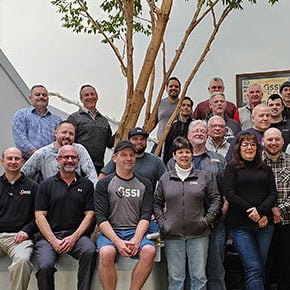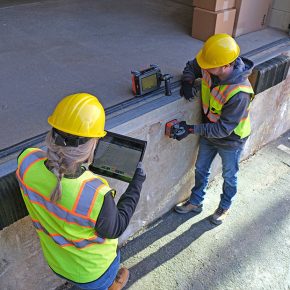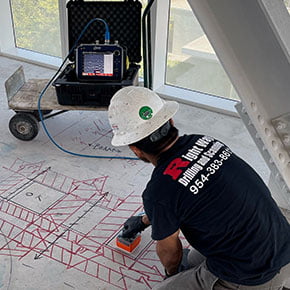GSSI Academy: Getting Started with RADAN 7
The GSSI Academy provides an overview of RADAN® 7 packages and modules to post-process GPR data. This post also provides instructions on how to activate your RADAN 7 software.
RADAN® is GSSI’s post-processing software for ground penetrating radar (GPR). Short for Radar Data Analyzer, RADAN was first developed by GSSI in 1984 and released in 1987 to post-process GPR data. This software allows users to select the processing functions that best suits their needs. RADAN is Windows™ based, which provides a familiar and easy-to-use environment for all levels of user experience. In 1994, RADAN changed from a disk operating system (DOS) to Windows.

RADAN 7 Software Options
There are three types of software packages for RADAN 7. RADAN 7 Main is the primary platform for all GPR applications. Users have the ability to customize their RADAN 7 software with additional modules:
3D: The 3D Module allows the user to view and build 3D visualizations. This module helps interpret and annotate complex subsurface structures and is often used to create report graphics.
RoadScan™: The RoadScan Module is used to analyze pavement, base, and sub-base layers in roadways.
BridgeScan™: The BridgeScan Module allows users to process bridge deck GPR data and account for skew angles. Features included aids users to map bridge deck deterioration and export data in multiple file formats, such as .kml and excel.
GSSI also offers two versions of RADAN that are application specific for the concrete inspection and utility locating markets. These packages are separate from RADAN 7 Main and cannot be upgraded.
RADAN 7 for StructureScan™ Mini is designed to process, view and document 2D and 3D data collected with the StructureScan Mini series systems.
RADAN 7 for UtilityScan® is designed to process, view and document 2D and 3D data collected with our UtilityScan product line.
How to Activate RADAN 7
When users purchase RADAN 7, they are provided a unique digital product key and serial number that is needed to install the software on their computer. RADAN 7 will automatically activate purchased modules when the activation codes are input. If one does not input the activation codes, the software will go into Demo Mode for 30 days or 33 uses, whichever comes first. After which, the software defaults to a RADAN Reader version.

File Types
When importing your GPR data into RADAN, you will see different files depending on the systems you collected the data on. Below we’ll list out the types of file names and differences between them.
- .DZT file: This is a raw GPR data file, containing two-way travel time and amplitude information. Depending on when a user’s control unit was released (SIR® 3000, SIR® 20, and all previous units), processes and filters will also be stored in this .DZT file. Any adjustments on the control unit to improve the radar signal will also be stored in this file.
- .DZX file: Once a user opens the .DZT file in RADAN and begins processing it, the software will automatically generate a .DZX file with the same name as the .DZT file. This .DZX file contains all processes undertaken in the software. Additionally, for GSSI’s newest products (SIR 4000, SIR 30, UtilityScan, StructureScan Mini) adjustments undertaken in the control unit will be stored in a .DZX file with the same name as the .DZT file. These two files must share the same name and “travel” together in order to be able to correctly open and use the files in RADAN.
- .DZA file: LineTrac accessories attached to a digital antenna with the SIR 4000 or StructureScan Mini XT also generate a .DZA file with the same name as the other files containing LineTrac data.
- .DZG file: GPS systems attached to the SIR 4000, SIR 30, or Utility Scan generate a .DZG file with the same name as the other GPR data files containing GPS coordinate data.
- .PLT and .TMF files: For users who collect GPS data on the SIR 3000 or SIR 20 using the Acumen Data Logger, the system will generate a .PLT and a .TMF file; these two files contain all GPS data.
- .B3D file: 3D files generated using the Quick 3D module with the SIR 3000 will be .B3D files. When opened in RADAN, the .B3D file will grab all of the other .DZT files and place them together in the correct order, thus enabling users to view a 3D file as a whole and interpret it in the software. After creating the entire 3D grid in the software, RADAN will automatically generate an .M3D file, which allows adjustments to the 3D grid from within RADAN.
- .BZX file: The Quick 3D and Scan 3D modules of the SIR 4000 and Structure Scan Mini generate .BZX files; when opening this file, the software will grab all of the relevant .DZT files and assemble them into a grid, much like with the .B3D file.
- .S3D file: Super 3D, or .S3D files, are generated in RADAN when multiple 3D grids are stitched together into a larger 3D image.
Setting up a Source Directory
Lastly, users should know how to generate and set up a source directory in RADAN before beginning any processing. The source directory tells the RADAN program where to look for the data for processing.
When opening the software, click on the global settings option, which will open a pane on the right side of the screen. Upon double clicking on the word source directory, a file browser will open allowing users to browse the location containing the data for processing. Once this source directory is set to the correct location, clicking “Home > Open” will open that source directory right away.
Note: If “Autosave files” is set to Yes when setting up the source directory, RADAN will automatically save files in the source directory in a folder called “PROC,” short for processed files. Alternatively, “Autosave files” can be set to No, which gives users the ability to rename files as they’re being created.
The GSSI Academy now offers RADAN classes in a virtual classroom. Visit the GSSI Academy for our class schedule.



